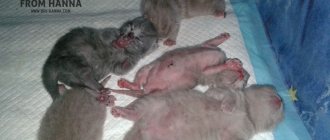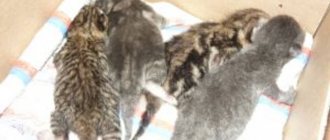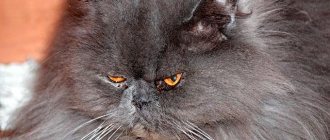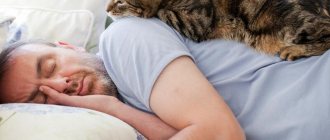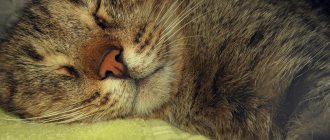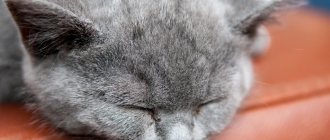Stimulation of labor in cats and preparation for it
Many owners who have got a cat and are faced with its first birth are wondering: how to help a cat give birth for the first time? The question is very relevant and correct, since when giving birth for the first time, an inexperienced cat panics and fusses - after all, this process is new to her and she can only guess at a natural level what exactly she needs to do.
The cat's behavior during this period may change beyond recognition. She may begin to rush around the house, meow hysterically and rub against her owner, calling him for help.
But what can the owner do? After all, he cannot know in advance how his pet will react to the kittens and to the process of delivery itself; there is a high probability of psychological trauma and physiological disorders in the body.
How a cat behaves during childbirth, especially the first, largely depends on the individual characteristics of the psyche and the body as a whole. Some individuals literally require the owner to be constantly nearby, need stroking and affection, while others, on the contrary, hiss and scratch the person, clearly making it clear that he should not come close. In such cases, all that remains is to observe and hope that the cat will cope on its own.
It happens that all the due dates set by the veterinarian for a cat pass, but the female is not going to give birth. How then can you help a cat give birth at home, because kittens gain weight and exhaust the cat more and more, foreshadowing problems with passage through the birth canal.
In such cases, only a veterinarian, but in no case the pet owner himself, can decide whether it will be necessary to help the cat give birth and how exactly to do this! For example, folk remedies used during childbirth for a “difficult” cat can provoke an even longer process, which will cause a protracted delivery, poor pushing, and bleeding.
The introduction of hormonal drugs such as Oxytocin or any other analogues for an unprepared cat can be the beginning of the end - a rupture of the cervix will occur. That is why the cat is examined in advance by a veterinarian-obstetrician and, based on the tests and data obtained, decides which drug should be used.
How to protect future offspring?
You can help your cat give birth to kittens alive and healthy through pregnancy prevention and preliminary preparation.:
- competent choice of a male means compatibility of blood groups, absence of hereditary diseases and cases of stillbirth in ancestors;
- It is not recommended to allow mating of related individuals;
- periodic diagnostics of a pet will identify infectious formations and reproductive problems in advance;
- in a veterinary clinic you can carry out deworming - elimination of parasites and worms;
Problems that may arise when giving birth to a cat
The table below highlights the most common problems that arise during the birthing process in cats and kittens, which the owner can overcome on their own.
Stage What's happening
Contractions have stopped or become weak
You need to wait some time. When 1-2 kittens are born, labor may subside and then reactivate (in some cases it can take up to a day). Labor can be stimulated by massaging the mammary glands and nipples. In extreme cases, it is possible to use oxytocin, a drug that promotes contractions of the uterine wall. It should be borne in mind that improper use of the product can cause the death of the mother and offspring.
The membrane remained intact
If the mustachioed mother has not torn the membrane of the amniotic sac, you need to carefully tear it apart, starting from the kitten's face.
The cub can't get out
If the baby gets stuck in the birth canal, the owner will have to help him: to do this, grab the kitten by the skin (on the withers or back of the body) and slowly pull it out. Manipulation should be carried out wearing gloves, the tips of which should be lubricated with Vaseline oil.
The umbilical cord remained intact
If the woman in labor has not gnawed the umbilical cord, and more than a quarter of an hour has passed since the kitten was born, it is necessary to do the following: step back from the kitten’s tummy about 4 cm, bandage or clamp it, and after half a minute cut it at the point of compression. The incision site must be treated with an antiseptic (brilliant).
Newborn is not breathing
You can try to gently shake it, lowering its muzzle down. A sign of oxygen entering the respiratory system is the pink color of the newborn’s tongue. In addition, it should make a squeaking noise.
Cat ignores baby
In this case, the owner must carry out the initial treatment of the kitten. It is necessary to wipe the newborn with a cloth and remove mucus from the respiratory tract using a syringe. After this, you need to place the baby on the nipple.
Important Notes
Firstly, we note that the fact of the birth of a stillborn kitten (even if it is the first) does not mean something catastrophically dangerous. Cats are prolific animals, and therefore, after a dead cub, they may well be born alive and healthy. Moreover, experienced breeders probably know that a certain percentage of waste always occurs.
Alas, inexorable veterinary statistics accumulated by practicing specialists around the world indicate that in purebred animals the risk of giving birth to dead kittens is always higher (and significantly) than in outbred “murks”. This is especially true for Persians: in some cases, up to 7% of kittens are born dead in pets of this breed, and another 9% of cubs die within the first week of life.
In general, it is the Persians who collect the most sad statistics: it is believed that if 75% of kittens are alive by the third week of life, then this is a very good result. It often happens that more than half of all newborns die. This deplorable situation is associated with a huge number of genetically transmitted diseases. There are cases where a third of the entire litter was born with severe liver pathologies (including the complete absence of this organ).
Secondly, it is necessary to distinguish between cases of stillbirth and infant death. Remember that in situations where a kitten dies within the first hours after birth (or even the first days), it is also customary to talk about “stillbirth”.
Thirdly, it is necessary to distinguish between situations when kittens were born dead, being still in the womb, and cases when the cubs, initially healthy (at least partially), died directly during the birth process.
Main predisposing factors
We list the most common causes of stillbirth encountered in veterinary practice:
- Hypoxia (lack of oxygen). This is a very common pathology in cases of protracted labor, when the kitten’s umbilical cord, which supplies its body with oxygen, is pinched in the birth canal. It is believed that in cases where a kitten remains in the birth canal for more than ten minutes, unable to be born, the risk of its death increases to almost 90%. Due to severe hypoxia, a kitten may be born alive, but you shouldn’t experience much joy from this: such pets often cannot even suck their mother’s milk. They subsequently develop serious developmental problems. As a rule, after some time they die anyway.
- Injuries received by babies directly during childbirth often lead to similar results. Studies have shown that cats with “extremes” of anatomical development (long-suffering Persians are especially “distinguished”) experience more problems during the birth process. Most likely, this is a consequence of the combination of the kittens’ large heads and narrow pelvises in cats of this breed.
- The percentage of stillborn kittens in litters of primiparous and old cats is much higher. Such animals are either inexperienced, or their body is not able to ensure the normal development of fruits. In addition, in old pets there are very frequent cases of severe uterine atony, which is why kittens are born for a long time, often getting “tightly” stuck in the birth canal.
It has been observed that cases of stillbirth are much more common in animals suffering from obesity. In addition, some cats produce milk long before birth, which (if it is not sucked out mechanically) leads to mastitis. Inflammation of the mammary glands significantly increases both the risk of stillbirth and the likelihood of infant death. Mastitis milk, saturated with decay products and pathogenic microflora, is not the best food for the delicate stomachs of kittens that have just been born.
Poor quality cat nutrition during pregnancy
It is vitally important to feed a pregnant cat correctly: not only the health and even the life of her kittens (even unborn ones) depends on this, but also the condition of the animal itself before and after birth. In particular, if you fed a pregnant pet low-quality food, then subsequently her body is unlikely to be able to produce a sufficient amount of nutritious milk.
That is, kittens, even having “managed” to be born alive, may well die soon after birth. In ideal cases, and if the owner has such an opportunity, we would advise feeding a pregnant cat with special commercial food. Poor nutrition during pregnancy can lead not only to stillbirth, but also to other problems that can lead to the death of kittens after they are born:
- Stress. As we already remember, the cat in this case can “with its own hands” kill its entire litter.
- Accelerated wear and tear and aging of the cat’s body.
- Maternal exhaustion.
- Dystocia or atony of the uterus.
- Mastitis. Do not be surprised - if there are mold spores or their toxins in the food, inflammation of the mammary glands is more than a typical pathology.
- Systemic diseases (including diabetes).
- Pathologies of skeletal development in kittens. There are cases described when babies are born literally “broken”, since the strength of their bones is no higher than that of rotten matches. The cat itself will almost certainly develop osteoporosis in such situations.
Signs that a cat has given birth completely
The belly of a giving birth cat, if it is assumed that all the kittens have come out, will be soft and without any lumps.
You need to feel it carefully, without using force. But it is impossible to judge the end of labor by the size of the abdomen, since the cat’s uterus contracts slowly, and even after a day retains its tone
The main guidelines indicating complete delivery are behavioral signs:
- The cat does not feel anxious, there are no attempts.
- The woman in labor is breathing smoothly, the heartbeat is rhythmic, the pulse is not rapid;
- The mother shows an active interest in the offspring, licks the kittens, feeds them, and moves them closer;
- She can change her body position, get up from the nest, and leave it for several minutes;
- After hard work, your pet feels increased appetite and thirst, eats and drinks with pleasure.
Complications of pregnancy in cats (relatively harmless)
• Cystitis
• Kidney failure
• Intestinal disorders (diarrhea\constipation)
• Allergies
• Arrhythmia
• Obesity\dystrophy
As a rule, such complications arise during early or late pregnancy of cats, with improper nutrition of cats, as well as when pregnant cats are on the street, hypothermia and overheating.
All these complications require treatment and monitoring by a veterinarian. They usually go away immediately after pregnancy and do not have a significant impact on the cat's health, but can lead to complications during childbirth and/or health problems in kittens. Each such complication has its own symptoms and its own methods of treatment.
With proper care, nutrition and general health of the cat, complications during pregnancy do not occur. In general, feline miscarriages and other complications are uncommon.
Causes of early mortality of kittens.
Hypothermia
(hypothermia). Newborn kittens are at risk of hypothermia because their bodies are unable to maintain body temperature, making them dependent on the cat and the temperature in the room. Hypothermia, in particular, is dangerous because it can cause a decrease in breathing and heart rate, which leads to cardiovascular failure. Also, with hypothermia, kittens often cannot suckle well, which accelerates the development of problems. Rectal temperature in kittens should be between 35-37°C in the first week, 36-38°C in the second and third weeks, and reaches a normal adult cat temperature of 38-39°C by the fourth week of life.
Low sugar level
in the blood (hypoglycemia). Newborn kittens need a lot of energy, but they have no reserves to conserve it, so they are completely dependent on their mother's milk. Sick kittens may not consume the required amount of milk, which quickly leads to the development of hypoglycemia. This can manifest itself in weakness, decreased temperature, squeaking, difficulty breathing, and convulsions.
Dehydration
(dehydration). At an early age, the risk of dehydration in kittens is increased, since their body contains a relatively high amount of fluid, and the mechanisms of protection against water loss have not yet been fully formed; water is quickly excreted through the kidneys, lungs and skin. Diarrhea also increases water loss. Normally, newborn kittens require approximately 130-220 ml/kg per day of water, while an adult cat only needs 50-65 ml/kg. Dehydration develops quickly when there is a lack of milk intake or increased water loss (usually as a result of overheating or diarrhea).
Negative environmental factors
Environmental factors are an important factor that directly influences the possibility of stillbirth. These include:
- Sudden changes in external temperature in the last stages of pregnancy. In such cases, the cat’s body may not be able to cope with normal thermoregulation, and therefore the kittens will suffer from hypothermia already in the womb. This has an extremely negative effect on the development of fruits. Hypothermia is also deadly for babies whose body weight is less than normal (as already indirectly mentioned above). What to do? To try to increase the chances of survival of such a baby, hold it in your hands for at least a few minutes. Practice proves that “warmed up” pets are slightly more likely to not die immediately after birth.
- Failure to comply with basic sanitary and hygienic standards when caring for a cat.
- Crowded housing of animals. This factor is especially typical for shelters and pet stores. Under such conditions, the likelihood of developing stress increases significantly, and the cat receives less nutrients, unable to fully compete for food with other animals.
- Stress and mental disorders of the cat itself (yes, animals also have mental problems). Under the influence of these factors, the cat itself can kill and even eat all the kittens that have just been born. In addition, in such cases, the mother very often abandons the cubs and refuses to feed them. If the owner does not take up artificial feeding (and this is an extremely complex and time-consuming procedure), the pets are doomed to death.
Proper nutrition comes first!
In the first ten days, the kitten should eat every hour , regardless of the time of day. Yes, it is extremely tiring, but only in this case does the baby have at least some chance of life. Most likely, you will have to dilute the mixture used to feed him. The fact is that the baby’s underdeveloped digestive system will not be able to digest food with normal fat content.
Let us warn you right away - you will have to buy special mixtures. Look at the food preparation instructions and add ¼ more water to dissolve it (compared to the original amount recommended). During one feeding, the baby will eat no more than two milliliters, since his stomach is very small. You should not prepare food for future use.
Varieties and their symptoms
One of the types of miscarriages that pose the least danger to your pet is fetal resorption in the early stages of pregnancy. In fact, the process may go unnoticed by you. The fruits do not necessarily all dissolve; sometimes some of them continue to develop normally. Much more serious is intrauterine fetal death, which can occur at any stage of pregnancy.
As for intrauterine fetal death without miscarriage, this is the most serious problem. In this case, your pet begins to bleed heavily, as well as purulent discharge (key symptoms). In addition, the cat refuses food, begins to vomit, and the temperature rises. The only sure way out is to contact a specialist as soon as possible.
Intrauterine death of kittens - causes and consequences
Most often, the reasons for the death of kittens before birth lie in intrauterine developmental disorders . Some embryos may die during multiple pregnancies. In this case, we can say that the body gets rid of excess load. In this case, the mother's body absorbs dead embryos. Congenital malformations that are incompatible with life may arise due to genetic defects or poor quality care for the mother in the early stages of pregnancy.
Quite often, intrauterine malformations are associated with chronic diseases of a pregnant cat . Constant stress, cold, physical damage, trauma and other external factors can lead to intrauterine death of kittens. It has been established that a deficiency of taurine in a cat's diet leads to a slowdown in the development of muscles and bones in fetuses. During cat pregnancy, it is not advisable to use any medications (especially toxic ones) without the prescription and supervision of a veterinarian.
If a pregnant cat is infected with the distemper virus (panleukopenia), stillborn offspring are considered a consequence of the disease. When an infection rages in the body, the development of the embryo stops, which leads to improper formation of the brain and deformation of the skull.
Chronic and viral leukemia is another dangerous pathology, which results in the death of the entire litter. Most often, kittens are born alive, but die within the first day after birth. In veterinary medicine, this phenomenon is called fading kitten syndrome.
In addition to viral pathologies, helminthic infestation affects the health and development of kittens. The larvae and eggs of some parasites can cross the placental barrier and infect or kill kittens in utero. Certain types of parasites cannot penetrate the placental barrier, but infect kittens immediately after the start of lactation (penetrate into milk).
Can a cat give birth within a few days of each other?
Has anyone else had this? This is fine? One kitten was born yesterday morning, a day passed and that’s it, no one else... and she still walks with a round belly.
If the cat feels and behaves normally, there is no bloody discharge, the kittens are moving in the stomach - wait for it to give birth on its own. The vets only cesarean.
My cat gave birth to a premature kitten (either pathology, or the cat was re-mated), she called the vets - “take it, we’ll cut it up.” Because The cat felt fine, no luck. After 5 days she gave birth to 3 healthy kittens.
The born kitten is alive, eats from its mother.. There is also something alive in the tummy, she feels great, eats, goes out for a walk, lies with him.. In general, she behaves as always. I decided to wait a couple of days or if her behavior does not change.
The born kitten is alive, eats from its mother.. There is also something alive in the tummy, she feels great, eats, goes out for a walk, lies with him.. In general, she behaves as always. I decided to wait a couple of days or if her behavior does not change.
Read, there is a lot of information about giving birth to cats, caring for newborn kittens, unusual situations, complications after childbirth, etc.
Read, there is a lot of information about giving birth to cats, caring for newborn kittens, unusual situations, complications after childbirth, etc.
The born kitten is alive, eats from its mother.. There is also something alive in the tummy, she feels great, eats, goes out for a walk, lies with him.. In general, she behaves as always. I decided to wait a couple of days or if her behavior does not change.
Read it, there is a lot of information about giving birth to cats, nursing newborn kittens, unusual situations, complications after childbirth, etc. Thank you, I found it, I’m reading
As I remember my cat, she gave birth every six months and killed kittens, I wanted to leave
Source
I still have one, perhaps strange question... how to determine that a cat has finished giving birth? According to my feelings, there are 2-3 kittens (future football players, judging by the activity)). When a cat gives birth to two, it calms down... how can we determine that this is all that is left unhurried/underdeveloped/dead?
An hour after the last kitten, give oxytocin 0.3 ml. if labor continues, then there will be attempts and more kittens will be born. Or the uterus will cleanse itself
To understand whether your cat’s labor has ended and whether all the kittens have come out, and not to sit or wait any longer, wasting time, you need to put the cat on all its paws and, holding the withers with one hand, with the other hand, take the stomach from below in your palm and squeeze it well. The empty belly is soft and can be felt all the way to the spine. If there are kittens, they are located on the sides of the abdomen or in the groin, both of which are easily palpable.
An hour after the last kitten, give oxytocin 0.3 ml. if labor continues, then there will be attempts and more kittens will be born. Or the uterus will cleanse itself
Normally, labor will continue and the uterus will cleanse itself without any oxytocin. In some cases, a break between kittens of about a day is possible.
IMHO, you just need to monitor the cat's condition. If after the birth of the kittens the contractions have stopped, the cat is eating well, taking care of the babies and by all signs feels normal, then there is no need to go to her with medications. And if he feels bad. There is also no need to bother, it is better to contact a veterinarian, because situations can be different - including those when oxytocin is strictly contraindicated and only emergency surgery can help.
To understand whether your cat’s labor has ended and whether all the kittens have come out, and not to sit or wait any longer, wasting time, you need to put the cat on all its paws and, holding the withers with one hand, with the other hand, take the stomach from below in your palm and squeeze it well. An empty belly is soft and
Prevention measures
Dead kittens can be born to a cat for various reasons. That is why the best solution for you is to take the necessary preventive measures to protect your pet from serious health problems.
What you should think about first is finding a healthy partner for the cat, always a non-blood relative. It is not recommended to plan mating for animals that are over 6–7 years old. It is also advisable to create a balanced daily diet for your cat, which will include taurine, vitamins and minerals.
It is very important to make sure that your pet does not consume products of questionable quality or stale ones. This could cause her poisoning. Additionally, encourage your cat to be physically active during pregnancy, but try to limit access to high surfaces. Another key point: immediately before mating, try to check both partners for the presence of infections in the body.
The period of pregnancy and childbirth in domestic animals, in this case cats, is a process that occurs in natural conditions, without human intervention. But there are also exceptions. For example, if a cat has caught an infection, gives birth for the first time, or there are dead kittens in the litter. In such cases, the question “how to help a cat give birth” is natural.
Here, of course, you cannot do without the help of the owner and the veterinarian, but how do you understand that the animal needs help and what needs to be done in such cases? Let's figure it out together.
If a cat’s pregnancy proceeded calmly, smoothly, without complications, then she should give birth without any problems. The main thing is not to be nervous, as the animal easily picks up the mood and vibrations emanating from the owner and also begins to noticeably worry, which can lead to problems during childbirth.
The cat should give birth primarily at home. This is preceded by two reasons at once - a feeling of calm and safety in one’s native territory and a low risk of contracting a bacterial infection.
If a cat’s pregnancy is difficult and with pathological processes, this is also not a death sentence for her giving birth in a veterinary clinic. The owner just needs to take the cat to an appointment in advance so that the veterinarian carefully examines the animal and is aware of possible problems that appear during childbirth. It is worth noting that this should not be an ordinary therapist, but a veterinary obstetrician.
If the owner doubts his abilities and is afraid to help the cat get wet, then it is better to leave her at the clinic, where veterinarians will look after her around the clock. This is especially true if the animal has heart or respiratory problems. As a rule, for such diseases, doctors recommend a cesarean section, and a little later sterilization.
Causes of stillbirth in cats
There are many reasons why an animal gives birth to dead kittens. Conventionally, they can be divided into the following groups:
1. Genetic reasons. This is a large group of factors that directly affects the viability of the offspring and is the reason why a cat gives birth to dead kittens:
Hereditary factor. If there are cases of stillbirth on the maternal and paternal lines of the mother cat, then the likelihood of stillbirth increases sharply.
Genetic abnormalities of fetal development (mutations and deformities).
Inbreeding (mating of closely related lines) is one of the common causes of stillbirth.
Blood group incompatibility. When breeding, this factor must be taken into account, since parental incompatibility leads to hemolytic disease of the newborn and stillbirth.
To date, cats have three blood types:
Blood type A
Formed through the following pair of genes: A/A or A/B, where A is the dominant gene and suppresses the properties of B
Blood type AB
Very rare and not yet fully studied
Please note that AB is a completely different blood type than A/B
Blood type B
formed through I/V genes. 2
Adverse factors during pregnancy:
2. Adverse factors during pregnancy:
Injuries during pregnancy. Blows and bruises, falls from a height of a pregnant female often lead to the birth of dead offspring.
The presence of diseases of an infectious or parasitic nature in the mother or father (chlamydia, listeriosis, toxoplasmosis, herpes, panleukopenia, etc.) is a common reason why a cat gave birth to dead kittens. In this case, diseases in animals can be asymptomatic, without obvious clinical signs or in the form of virus carriage.
Herpes on a cat's lip
Inflammatory diseases of the female reproductive system. Metritis, endometritis, inflammatory processes in the genitourinary area lead to disruption of pregnancy, the supply of nutrients and oxygen to the babies in the womb.
Poor nutrition and maintenance of a pregnant cat. An inadequate and low-calorie diet of the female, a lack of vitamins and minerals are common reasons why a cat gives birth to dead kittens. Lack of physical activity and physical inactivity lead to oxygen starvation of the fetus in the womb.
3. Adverse factors during childbirth. Quite often, the cause of stillbirth is deviations in normal labor:
Complications during childbirth (incomplete dilatation of the birth canal, prolonged labor) lead to kittens suffocating as a result of strong pushing and delay in the birth canal.
The animal owner's inexperience in determining its viability is also often the reason why the baby is mistakenly considered stillborn. This group of reasons also includes incorrect actions (or inaction) of the owner to revive the kitten.
4. Other factors. The reasons for the birth of stillborn kittens can be not only genetic diseases, illnesses and injuries, but also other factors that must be taken into account:
Number of previous pregnancies. Very often, non-living offspring are born to a primiparous cat, as well as to an animal with a small number of pregnancies. The more often an animal gives birth, the less likely it is to give birth to stillborn kittens.
Mother's weight. A large cat is more likely to give birth to a stillborn litter than an animal of average weight. This is due to the fact that a thick fatty layer of internal organs, including the uterus, leads to hypoxia of the fetus in the womb.
The variety of causes and factors leading to stillbirth makes diagnosis and preventive measures difficult.
First aid
If the owner has not previously helped the pet in this process, then he may consider a completely alive and simply inactive baby to be dead.
Often a provocateur for the fact that small kittens have died is the fact of inexperience or illiteracy of the owner of the giving birth pet. Sometimes a person is not able to distinguish between the presence and absence of signs of life in a baby. Newborn kittens may not move or meow, causing the owner to decide that the baby is dead. To prevent a cat from giving birth to dead kittens, it is important to ensure safe gestation conditions, contact a veterinarian for assistance during childbirth, and also be able to provide first aid to newborn babies.
The algorithm of actions is as follows:
- Remove the baby from the hymen, allowing it to breathe.
- You can pinch the umbilical cord with your fingers, at a distance of 2 cm from the tummy, and cut it off with sterile scissors.
- Wash the wound with an antiseptic.
- Free the mouth and nose from mucus using a small syringe, and then turn the head down.
- Help the kitten breathe by breathing “mouth to mouth” according to the rules:
- take a straw;
- insert into baby's mouth;
- blow in a little air every 3-5 seconds.
To cut the umbilical cord, you must use a sterile instrument.
Usually, the mother cat frees the hymen by licking the lumps that appear. But, if this is not possible (the pet has abandoned the baby or is busy giving birth to other kittens), you can imitate the mother’s movements. To do this, wrap your finger in a napkin and do a light massage: from the forehead to the back, from the tail to the neck and along the area from the throat to the tail on the stomach. Some breeders use ammonia to revive it by placing a piece of cotton wool soaked in a small amount of solution to the spout. Trying to bring a baby back to life if it smells bad initially is not advisable, since the newborn kitten died in the womb.
In this situation, baby massage can be effective.
Resuscitation is carried out for no more than 20 minutes in the presence of heartbeats, but up to 7 minutes in the absence of a pulse.
Actions of the owner upon the birth of stillborn kittens
Cat owners are not always mentally prepared for the birth of a premature kitten. To begin with, it is advisable to carry out certain resuscitation measures. If appropriate manipulations do not help revive the cub within 25 minutes, then the animal can be considered dead. In this case, it is recommended to isolate the dead offspring from the cat and wrap them in cellophane.
After these steps, you should definitely visit a veterinarian to autopsy the dead kittens, which will allow you to determine the exact cause of their death. A pathological examination allows us to thoroughly determine the causes of stillbirth, such as abnormalities in fetal development, infectious and bacterial diseases, as well as injuries and bruises during pregnancy.
After the female’s health returns to normal after a difficult birth, she and the male should also be shown to a specialist to determine the reasons that led to the stillbirth. Diagnostic measures will be aimed at determining the inflammatory processes of the female reproductive system, possible incompatibility of blood groups and the presence of hidden infectious diseases in both parents.
Stillbirth is a dangerous phenomenon for animal health. Sometimes spontaneous abortion is asymptomatic, which creates difficulties in diagnosing the pathology. Preventive measures will reduce the likelihood of a cat miscarriage and prevent complications after pathology.
What should the owner do?
What to do if your cat gives birth to stillborn kittens is to call your veterinarian. It is advisable for a specialist to come to your home so that you do not have to disturb the woman in labor again. If this is not possible, you need to take her to a veterinary hospital as carefully as possible.
The veterinarian will first take all the necessary tests from her (hematological blood test, analysis for the presence of infectious diseases, ultrasound of the abdominal cavity, etc.). Once an accurate diagnosis is made, your pet will be prescribed treatment.
Signs of labor that will take place in 1-2 days
At this point, manifestations depend on how attached the cat is to its owners. If she completely trusts people, then it is not difficult to notice the signs of an imminent birth. The main one is an invitation to join in the process of childbirth. The cat begins to constantly follow the person and often call him to follow him, taking him to the box in which lambing will occur. She can lie down on the bedding with her belly up and remain in this position until the owner leaves. If you look closely, at this moment you can see the kittens moving inside the belly. They will mix into the desired position gradually, not in 1 day.
Also, the approaching moment of the birth of kittens is indicated by the fact that the pet begins to wash itself frequently, actively licking the area under the tail. She can even completely lick off all the fur in the genital area, which makes the birth of offspring easier, since the kittens will not have to get tangled in their mother’s fur coat.
From this point on, all the tools that may be required when receiving kittens should be prepared. You also need to have the phone number of a veterinarian on hand, who can immediately arrive and provide all the necessary assistance, including surgical intervention.
Symptoms of premature birth
In a normal pregnancy, the expectant mother begins to prepare for childbirth about a week in advance. This is easy to notice - the cat is fussing, looking for secluded places, meowing loudly, and eating poorly. But premature lambing can begin suddenly.
Signs of premature lambing:
- The cat has bloody or thin discharge.
- Her stomach became hard.
- The animal became lethargic or, conversely, fussed too much.
- The pet refuses water and food.
- Breathing has become faster, contractions (spasms in the abdominal area) are observed.
Can a cat give birth within a few days of each other?
Has anyone else had this? This is fine? One kitten was born yesterday morning, a day passed and that’s it, no one else... and she still walks with a round belly.
If the cat feels and behaves normally, there is no bloody discharge, the kittens are moving in the stomach - wait for it to give birth on its own. The vets only cesarean.
My cat gave birth to a premature kitten (either pathology, or the cat was re-mated), she called the vets - “take it, we’ll cut it up.” Because The cat felt fine, no luck. After 5 days she gave birth to 3 healthy kittens.
The born kitten is alive, eats from its mother.. There is also something alive in the tummy, she feels great, eats, goes out for a walk, lies with him.. In general, she behaves as always. I decided to wait a couple of days or if her behavior does not change.
The born kitten is alive, eats from its mother.. There is also something alive in the tummy, she feels great, eats, goes out for a walk, lies with him.. In general, she behaves as always. I decided to wait a couple of days or if her behavior does not change.
Read, there is a lot of information about giving birth to cats, caring for newborn kittens, unusual situations, complications after childbirth, etc.
Read, there is a lot of information about giving birth to cats, caring for newborn kittens, unusual situations, complications after childbirth, etc.
The born kitten is alive, eats from its mother.. There is also something alive in the tummy, she feels great, eats, goes out for a walk, lies with him.. In general, she behaves as always. I decided to wait a couple of days or if her behavior does not change.
Read, there is a lot of information about giving birth to cats, caring for newborn kittens, unusual situations, complications after childbirth, etc.
Source


